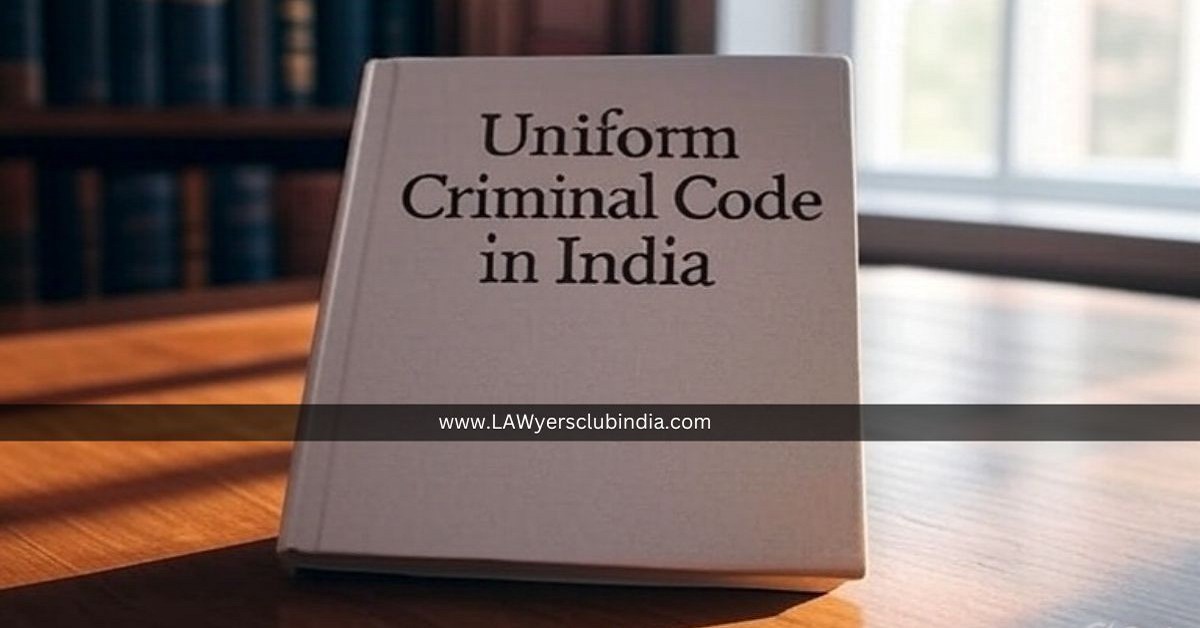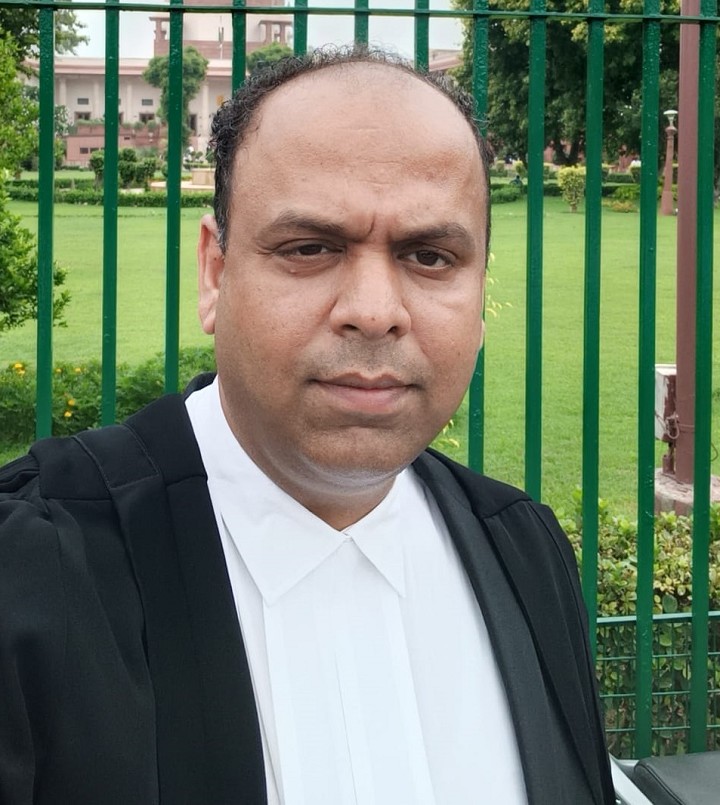Uniform Criminal Code: Reclaiming the Constitutional Promise of Equal Justice
"The law must be equal for all, and justice must not be a privilege of the few."
Authored by: Md. Zaryab Jamal Rizvi
India's constitutional democracy is founded upon the ideals of justice, liberty, equality, and fraternity as enshrined in the Preamble to the Constitution. Among these, the principle of equality before the law and equal protection of laws under Article 14 occupies a position of cardinal importance. However, despite the guarantee of equal treatment, the reality of India's criminal justice system tells a different story, one of fragmented procedures, arbitrary classifications, and the existence of multiple criminal statutes with divergent procedural norms. While the debate over the Uniform Civil Code (UCC) has long dominated the legal and political discourse, there has been inadequate focus on an equally vital issue: the need for a Uniform Criminal Code (UCrC). This article explores the constitutional, legal, and practical necessity of enacting a Uniform Criminal Code in India by examining existing statutory anomalies, procedural irregularities, and the broader implications of unequal treatment in criminal justice.

To understand the need for a uniform procedural code, it is essential to begin with the current structure of criminal law in India. The Indian Penal Code, 1860 (IPC)&Bharatiya Nyaya Sanhita, 2023 (BNS) remains the primary source of substantive criminal law, while the Code of Criminal Procedure, 1973 (CrPC)&the Bharatiya Nagarik Suraksha Sanhita, 2023 (BNSS), lays down the procedural framework for investigation, arrest, bail, trial, and sentencing. However, over the decades, Parliament has also enacted a range of special criminal statutes, each with its own substantive provisions and procedural deviations. These include, among others, the Narcotic Drugs and Psychotropic Substances Act, 1985 (NDPS Act), the Unlawful Activities (Prevention) Act, 1967 (UAPA), the Prevention of Money Laundering Act, 2002 (PMLA), the Protection of Children from Sexual Offences Act, 2012 (POCSO Act), and the Juvenile Justice (Care and Protection of Children) Act, 2015.
While it may be reasonable to argue that certain crimes, by their nature, require stricter provisions, such as terrorism or money laundering, what remains constitutionally suspect is the unequal treatment meted out to similarly situated persons based solely on the statute invoked. For instance, an individual accused of possessing a narcotic substance may be denied bail for months, whereas another individual accused of a similar or graver offence under the IPC may be granted bail under Section 437 or Section 439 of the CrPC. The CrPC, in its general framework, recognizes the presumption of innocence as a cardinal principle. However, Section 37 of the NDPS Act reverses this presumption by mandating that bail cannot be granted unless the court is satisfied that the accused is not guilty and is unlikely to commit any offence while on bail. Similarly, Section 43D(5) of the UAPA imposes a virtual embargo on bail by requiring the court to form an opinion that the accusations against the accused are prima facie untrue, a standard significantly higher than what CrPC requires.
The problem becomes more acute when one considers the overlap of jurisdiction and the multiplicity of laws. A single act may attract provisions of the IPC, NDPS, and UAPA simultaneously, and the investigating agency often exercises discretion in choosing which statute to invoke. This discretion, unchecked and unguided, can lead to misuse, forum shopping, and arbitrary prosecution. The consequences are stark: longer periods of pre-trial incarceration, denial of basic procedural rights, and the undermining of judicial discretion. The Hon'ble Supreme Court in Union of India v. K.A. Najeeb, (2021) 3 SCC 713, while granting bail under UAPA, emphasized that statutory restrictions on bail cannot override the constitutional mandate of protecting personal liberty under Article 21 of the Constitution.
Moreover, the PMLA introduces yet another layer of procedural complexity. The Enforcement Directorate, under the Act, is granted wide-ranging powers, including the power to arrest without a warrant (Section 19), attach property suspected to be proceeds of crime (Section 5), and conduct searches and seizures with minimal judicial oversight. In Vijay Madanlal Choudhary v. Union of India, (2022) 10 SCC 1, the Hon'ble Supreme Court upheld the constitutionality of many provisions of the PMLA, but the dissenting opinions and critiques by legal scholars underline the growing discomfort with the erosion of procedural safeguards. Notably, Section 45 of the PMLA, like the NDPS Act, imposes stringent conditions for bail, including the requirement that the public prosecutor must be given an opportunity to oppose bail and that the court must be satisfied that the accused is not guilty.
These statutory divergences are not merely legalistic distinctions, they strike at the root of the concept of procedural fairness. The principle of natural justice, which forms part of the basic structure of the Constitution as laid down in Indira Nehru Gandhi v. Raj Narain, 1975 Supp SCC 1, demands that every individual must be treated equally and fairly by the legal system. However, by creating multiple classes of accused persons, based not on the gravity of the offence but on the statute under which the offence is prosecuted, the current legal framework undermines the principle of equality before law, as enshrined in Article 14.
Another layer of disparity arises from the federal structure of India, where both the Union and the States are empowered to legislate on criminal law and procedure under Entries 1 and 2 of the Concurrent List (List III) of the Seventh Schedule. According to Article 254, where a state law conflicts with a central law on a concurrent subject, the central law prevails unless the state law has received Presidential assent. This has resulted in a situation where certain procedural safeguards available under CrPC are excluded by state amendments. For example, anticipatory bail under Section 438 of the CrPC was not available in the states of Uttar Pradesh and Uttarakhand until 2019, despite being available in the rest of the country. Such geographical inconsistencies mean that an accused person's rights may vary dramatically depending on the state in which they are arrested, a position clearly inconsistent with the constitutional mandate of uniform protection.
The inconsistency is not limited to procedural law alone; even the definition of certain offences and the nature of penalties differ across states. For instance, laws relating to cow slaughter or religious conversions vary dramatically among states, with some states like Gujarat and Uttar Pradesh, imposing harsh penalties, while others do not criminalise these acts at all. These inconsistencies in approach again call into question the logic of selective procedural and substantive protections.
The absence of a Uniform Criminal Code also facilitates forum shopping by enforcement agencies, especially in politically sensitive cases. A person may be booked under the UAPA or some of the other special legislations instead of the IPC or CrPC provisions, purely to deny them access to bail or other procedural safeguards. This is a direct affront to the jurisprudential principle that the process should not become the punishment. The Hon'ble Supreme Court in Arnab Manoranjan Goswami v. State of Maharashtra, (2021) 2 SCC 427, while granting relief under Article 32, reiterated that criminal law must not be used as a tool for harassment or selective targeting.
To rectify this deeply fractured framework, the proposal for a Uniform Criminal Code assumes significance. Unlike the Uniform Civil Code, which concerns itself with harmonising personal laws across religions, the Uniform Criminal Code would seek to create a single, coherent procedural and enforcement framework for all criminal statutes, ensuring that the rights of the accused, investigation protocols, arrest procedures, bail conditions, and evidentiary standards remain consistent and non-discriminatory. This does not mean that all special laws must be repealed or homogenised. Instead, the objective is to ensure that the procedural rights of an accused are not disproportionately curtailed simply because the prosecution has chosen a particular statute.
The principle of uniformity in procedure does not negate the need for enhanced penalties or special mechanisms in exceptional cases. However, such exceptions must be narrowly tailored, constitutionally justified, and judicially reviewable. The law must draw a distinction between substantive innovation and procedural oppression. Just as Article 21 guarantees that no person shall be deprived of life or personal liberty except according to a procedure established by law, that procedure must also be just, fair, and reasonable as held in the landmark decision of Maneka Gandhi v. Union of India, (1978) 1 SCC 248.
Another significant challenge to legal uniformity in India arises from the existence of multiple precedents rendered by different Hon'ble High Courts, each exercising jurisdiction over its respective state or territory. These High Court decisions, while authoritative within their own territorial boundaries, are not binding on other High Courts and hold only persuasive value outside their jurisdiction. As a result, there is a proliferation of divergent judicial views on similar or even identical legal questions. This divergence is further exacerbated by the presence of state-specific legislations and amendments, laws enacted by State Legislatures under their respective entries in the State List or Concurrent List under the Seventh Schedule of the Constitution. For example, certain procedural or substantive legal provisions may vary in their application due to state amendments to central laws like the Code of Civil Procedure, 1908 or the Indian Stamp Act, 1899. Consequently, litigants and legal practitioners across states may be subject to varying interpretations and applications of the same central enactment, depending upon the state in which the case arises. This disjointed landscape undermines the principle of legal certainty and impedes the creation of a harmonized pan-Indian jurisprudence. Though the doctrine of precedent, as elaborated by the Hon'ble Supreme Court in Union of India v. Raghubir Singh, (1989) 2 SCC 754, requires trial courts and tribunals to follow decisions of courts of higher authority, it does not extend to inter-High Court precedents, thus creating a vacuum of uniformity. The situation becomes particularly problematic when conflicting High Court decisions remain unresolved by the Hon'ble Supreme Court, leaving subordinate courts and administrative authorities in different states to choose between competing views. This judicial fragmentation calls for either legislative intervention or timely authoritative pronouncements by the Apex Court to ensure coherence in the interpretation and enforcement of laws throughout the country.
Recent developments in Indian criminal law reform offer a window of opportunity to bring about such uniformity. The replacement of colonial-era codes with the Bharatiya Nyaya Sanhita, 2023, the Bharatiya Nagarik Suraksha Sanhita, 2023, and the BharatiyaSakshyaAdhiniyam, 2023 indicates the legislature's willingness to modernise the legal system. However, these efforts must go beyond mere cosmetic changes and engage with the deeper structural inconsistencies that plague the criminal justice system. The enactment of these new codes should be accompanied by a comprehensive review of all special criminal statutes to identify procedural anomalies and to bring them in line with a unified procedural framework.
Towards this goal, the Law Commission of India may be entrusted with the task of drafting a model Uniform Criminal Procedure Code, which may be made applicable to all criminal statutes with specific carve-outs only where absolutely necessary. Public consultations with stakeholders-including judges, lawyers, law enforcement officers, academics, and civil society-should be undertaken to ensure transparency and inclusiveness. Judicial oversight, particularly in the form of appellate review of procedural deviations, must be strengthened to safeguard against executive overreach.
In conclusion, the call for a Uniform Criminal Code is not merely a technical reform-it is a constitutional and moral imperative. It stems from the foundational belief that all citizens are equal before the law, and that justice must not vary with geography, religion, caste, or political context. By creating a consistent and fair criminal procedure applicable to all statutes and all persons, India can fulfil its tryst with justice and liberty. A crime must remain a crime regardless of the law under which it is prosecuted, and the process of adjudication must reflect the values of due process, human dignity, and constitutional fidelity. The time has come to move beyond fragmented justice and to embrace the vision of a truly uniform, equal, and just criminal law framework.

Adv. Zaryab Jamal Rizvi
Founding Partner: LCZF Law Firm
(Md. Zaryab Jamal Rizvi is a Supreme Court Advocate and Founding Partner at LCZF (Law Firm), New Delhi. He isa trained Mediator, he serves as a Board Member of the U.P. Shia Central Waqf Board and is also a Guest Faculty at Symbiosis Law School, Noida, amongst several other roles. He has about 20 years of legal experience and has been honoured with several awards for his contributions to the field of law.)
Join LAWyersClubIndia's network for daily News Updates, Judgment Summaries, Articles, Forum Threads, Online Law Courses, and MUCH MORE!!"
Tags :Others











